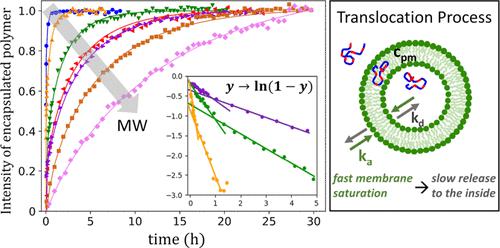当前位置:
X-MOL 学术
›
J. Am. Chem. Soc.
›
论文详情
Our official English website, www.x-mol.net, welcomes your
feedback! (Note: you will need to create a separate account there.)
Passive Macromolecular Translocation Mechanism through Lipid Membranes
Journal of the American Chemical Society ( IF 14.4 ) Pub Date : 2022-08-11 , DOI: 10.1021/jacs.2c06659 Ekaterina Kostyurina 1 , Jürgen Allgaier 1 , Margarita Kruteva 1 , Henrich Frielinghaus 2 , Agnes Csiszár 3 , Stephan Förster 1, 2 , Ralf Biehl 1
Journal of the American Chemical Society ( IF 14.4 ) Pub Date : 2022-08-11 , DOI: 10.1021/jacs.2c06659 Ekaterina Kostyurina 1 , Jürgen Allgaier 1 , Margarita Kruteva 1 , Henrich Frielinghaus 2 , Agnes Csiszár 3 , Stephan Förster 1, 2 , Ralf Biehl 1
Affiliation

|
The translocation of biologically active macromolecules through cell membranes is of vital importance for cells and is a key process for drug delivery. Proteins exploit specific conformational changes in their secondary structure to facilitate membrane translocation. For the large class of biological and synthetic macromolecules, where such conformational adaptions are not possible, guidelines to tailor the structure of monomers and macromolecules to aid membrane translocation and cross-membrane drug delivery would be highly desirable. Here, we use alternating amphiphilic macromolecules to systematically investigate the relation between polarity, polymer chain length, lipid chain length, polymer concentration, and temperature on membrane partition and translocation rate. We employed pulse field gradient NMR and confocal fluorescence microscopy to determine membrane adsorption and desorption rate constants and partitioning coefficients. We find that translocation is a two-step process involving a fast adsorption and membrane insertion process and a slower desorption process. Membrane insertion is a key step that determines the molecular weight, concentration, and temperature dependences. Passive translocation is possible on time scales from minutes to hours. Macromolecules with different adapted hydrophilic/hydrophobic comonomer sequences show the same translocation rate, indicating that common optimized translocation conditions can be realized with a variety of monomer chemical structures. The investigated copolymers are biocompatible, biodegradable, and capable of transporting a hydrophobic payload through the lipid membrane. This detailed understanding of the macromolecular translocation mechanism enables to better tailor the delivery of active agents using macromolecular carriers.
中文翻译:

通过脂质膜的被动大分子易位机制
生物活性大分子通过细胞膜的易位对细胞至关重要,是药物递送的关键过程。蛋白质利用其二级结构中的特定构象变化来促进膜易位。对于大类生物和合成大分子,在这种构象适应是不可能的情况下,定制单体和大分子结构以帮助膜易位和跨膜药物递送的指南将是非常可取的。在这里,我们使用交替的两亲大分子系统地研究极性、聚合物链长、脂质链长、聚合物浓度和温度对膜分配和易位率的关系。我们采用脉冲场梯度核磁共振和共聚焦荧光显微镜来确定膜吸附和解吸速率常数和分配系数。我们发现易位是一个两步过程,包括快速吸附和膜插入过程和较慢的解吸过程。膜插入是决定分子量、浓度和温度依赖性的关键步骤。在从几分钟到几小时的时间尺度上,被动易位是可能的。具有不同适应的亲水/疏水共聚单体序列的大分子显示出相同的易位率,表明可以通过多种单体化学结构实现常见的优化易位条件。所研究的共聚物具有生物相容性、可生物降解性、并且能够通过脂质膜运输疏水性有效载荷。这种对大分子易位机制的详细了解能够更好地定制使用大分子载体的活性剂的递送。
更新日期:2022-08-11
中文翻译:

通过脂质膜的被动大分子易位机制
生物活性大分子通过细胞膜的易位对细胞至关重要,是药物递送的关键过程。蛋白质利用其二级结构中的特定构象变化来促进膜易位。对于大类生物和合成大分子,在这种构象适应是不可能的情况下,定制单体和大分子结构以帮助膜易位和跨膜药物递送的指南将是非常可取的。在这里,我们使用交替的两亲大分子系统地研究极性、聚合物链长、脂质链长、聚合物浓度和温度对膜分配和易位率的关系。我们采用脉冲场梯度核磁共振和共聚焦荧光显微镜来确定膜吸附和解吸速率常数和分配系数。我们发现易位是一个两步过程,包括快速吸附和膜插入过程和较慢的解吸过程。膜插入是决定分子量、浓度和温度依赖性的关键步骤。在从几分钟到几小时的时间尺度上,被动易位是可能的。具有不同适应的亲水/疏水共聚单体序列的大分子显示出相同的易位率,表明可以通过多种单体化学结构实现常见的优化易位条件。所研究的共聚物具有生物相容性、可生物降解性、并且能够通过脂质膜运输疏水性有效载荷。这种对大分子易位机制的详细了解能够更好地定制使用大分子载体的活性剂的递送。











































 京公网安备 11010802027423号
京公网安备 11010802027423号